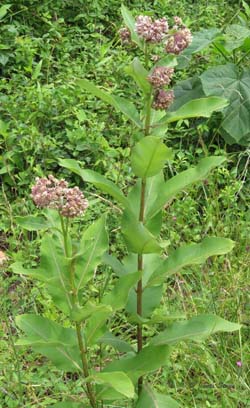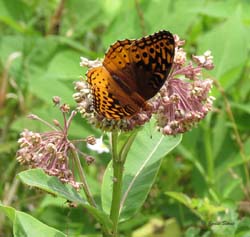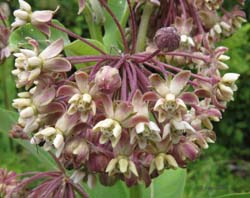Asclepias syriaca
Common Milkweed
[ click on any image below to see larger version ]
Family:
Apocynaceae
Mid-Atlantic bloom time:
June - August
Common Milkweed flowers are greenish-pink to rosy pink to purplish-pink and smell very sweet.
The fruit pods are covered in little finger-like projections.
The genus name Asclepias refers to the Greek god of medicine Asklepios.
The species name syriaca means ‘of Syria’, referring to Linnaeus's mistaken belief it was from Syria.
Common Milkweed grows readily from seed and spreads quickly by deep rhizomes.
It can be weedy and difficult to remove once established, so
care should be used to plant it only in places where this spreading habit can be tolerated.
In addition to its historical use as a wart remover, an interesting note from a
USDA Forest Service webpage (2014) says:
"Milkweeds contain various levels of cardiac glycoside compounds which render the plants toxic to most insects and animals. For some insects, the cardiac glycosides become a defense. They can store them in their tissue which renders them inedible or toxic to other animals. Monarch butterflies use this defense and birds leave them and the caterpillars alone. What the birds do not know is that northern monarchs feeding on common milkweed accumulate relatively little of the toxic compounds and probably would be edible. The more southern butterflies accumulate large amounts of the compounds from other milkweed species and are in fact toxic."
26 June 2014
Bull Run Mountains Natural Area Preserve, Landmark, VA

|
26 June 2014
Bull Run Mountains Natural Area Preserve, Landmark, VA

|
26 June 2014
Bull Run Mountains Natural Area Preserve, Landmark, VA
(with Great Spangled Fritillary)

|
26 June 2014
Bull Run Mountains Natural Area Preserve, Landmark, VA

|
Return to list of flora



